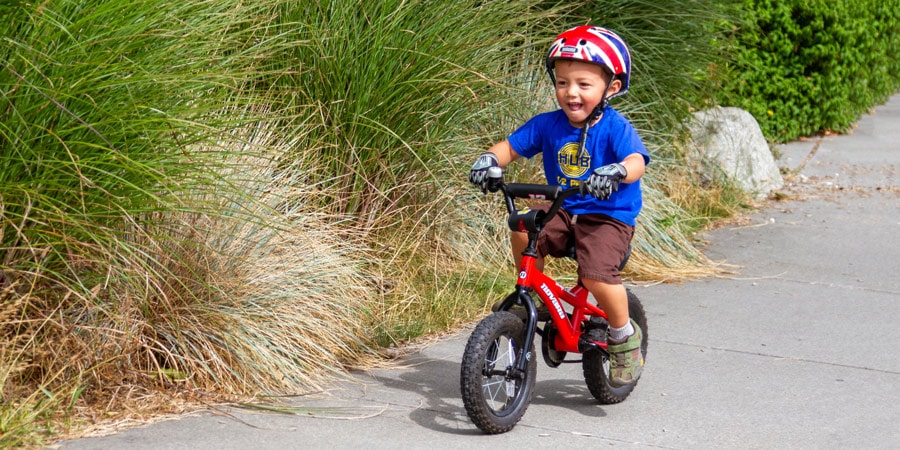What’s the best way to teach a toddler to ride a bike? The easiest way to teach a toddler to ride a bike is to start with a balance bike, allowing them to develop crucial balancing skills before introducing pedals. This guide provides a step-by-step approach, covering everything from choosing the right bike to celebrating your child’s cycling success.

Image Source: www.rei.com
The Journey to Two Wheels: A Toddler Bike Riding Progression
Teaching toddler cycling is an exciting milestone for both parent and child. The toddler bike riding progression involves several steps, each building upon the previous one. This journey typically starts with introducing your child to the concept of riding, moving to balance bikes, and finally graduating to a pedal bike.
Is Your Toddler Ready to Ride? Deciding on the Best Age
When is the best age to teach a toddler to ride a bike? While there’s no one-size-fits-all answer, most toddlers are ready to start around 2-3 years old with a balance bike, and 4-5 years old for a pedal bike. Look for these readiness signs:
- Coordination: Can your toddler walk and run easily?
- Balance: Do they have good balance while playing?
- Interest: Are they showing interest in bikes and scooters?
- Listening Skills: Can they follow simple instructions?
If your child displays these signs, they are likely ready to begin their toddler bike training journey.
Phase 1: Building Confidence – The Balance Bike for Toddlers
The balance bike is the secret weapon in helping toddler ride a bike successfully. A balance bike for toddlers allows them to focus solely on balancing and steering without the added complication of pedals.
Selecting the Perfect Balance Bike
Choosing the right balance bike is crucial. Consider these factors:
- Size: The child should be able to comfortably sit on the seat with their feet flat on the ground and a slight bend in their knees.
- Weight: Opt for a lightweight bike that your toddler can easily maneuver and pick up.
- Tires: Air-filled tires provide a smoother ride than solid tires, especially on uneven surfaces.
- Brakes: While not essential initially, hand brakes can be a useful feature to introduce later on.
- Adjustability: A bike with an adjustable seat and handlebars will accommodate your child’s growth.
Here’s a table comparing different balance bike features:
| Feature | Benefit |
|---|---|
| Lightweight | Easier for the child to control and pick up. |
| Adjustable Seat | Allows the bike to grow with the child. |
| Air-filled Tires | Provides a smoother, more comfortable ride, especially on rough terrain. |
| Hand Brakes | Teaches early braking skills (optional). |
Getting Started with the Balance Bike
- Introduce the Bike: Let your toddler get acquainted with the bike indoors. Encourage them to touch it, sit on it, and walk alongside it.
- Walking with the Bike: Start by having them walk with the bike between their legs, pushing it forward. Focus on getting them comfortable with the feeling of the bike.
- Gliding: Once they’re comfortable walking, encourage them to lift their feet and glide for short distances.
- Steering: As they become more confident, introduce steering. Set up some cones or obstacles for them to navigate around.
- Practice, Practice, Practice: The key to success is consistent practice. Short, frequent sessions are more effective than long, infrequent ones.
Important Safety Measures
- Helmet: Always, always, always wear a properly fitted helmet.
- Protective Gear: Consider knee and elbow pads, especially when starting out.
- Safe Environment: Choose a smooth, flat surface away from traffic. Parks, bike paths, and empty parking lots are ideal.
- Supervision: Always supervise your child while they are riding.
Phase 2: Transitioning to Pedals – Teaching Toddler Cycling
Once your toddler has mastered balancing and steering on a balance bike, it’s time to introduce pedals. Helping toddler ride a bike with pedals can be a smooth process if they have built a strong foundation with a balance bike.
Choosing the Right Pedal Bike
When selecting a pedal bike, consider these factors:
- Size: Just like with the balance bike, the right size is crucial. The child should be able to stand over the bike with their feet flat on the ground and have a few inches of clearance.
- Lightweight: A lighter bike is easier for a child to handle and maneuver.
- Coaster Brakes vs. Hand Brakes: Coaster brakes (pedaling backward to brake) are often easier for young children to use initially, but hand brakes provide better control and are important to learn eventually. Look for bikes with both if possible.
- Adjustability: Ensure the seat and handlebars are adjustable to accommodate your child’s growth.
Removing the Training Wheels: A Stance Against Training Wheels
Many parents consider training wheels, but most experts recommend skipping them altogether. Training wheels can actually hinder a child’s progress by preventing them from learning to balance properly. They create a false sense of security and can make the transition to riding without them more difficult. Instead, leverage the balancing skills acquired from the balance bike. This aligns with the concept of a toddler bike without training wheels.
Teaching Pedaling and Braking
- Lower the Seat: Lower the seat so that your child can comfortably place their feet flat on the ground. This will allow them to use their feet for balance while they get used to pedaling.
- Scooting with Pedals: Have your child scoot with the bike, using their feet to push off the ground. This will help them get a feel for the weight and balance of the bike with pedals.
- Introducing Pedals: Once they are comfortable scooting, encourage them to lift their feet and try pedaling. Start with short distances and gradually increase the length of their rides.
- Practice Braking: Teach your child how to use the brakes. Have them practice stopping in a safe, controlled environment.
- Find a Gentle Slope: A slight downhill slope can provide a gentle push to help them get started with pedaling.
Tips for Supporting Your Child
- Hold the Bike: Initially, you can hold the bike by the seat or handlebars to provide support. Avoid running alongside your child, as this can be tiring for you and doesn’t help them learn to balance.
- Positive Reinforcement: Offer plenty of encouragement and praise. Celebrate their successes, no matter how small.
- Patience: Learning to ride takes time and patience. Don’t get discouraged if your child doesn’t get it right away.
- Make it Fun: Turn bike riding into a fun activity. Go on bike rides to the park or explore new trails.
Troubleshooting Common Challenges
Even with the best preparation, you may encounter some challenges along the way. Here are some common issues and how to address them:
- Fear: If your child is afraid, reassure them and take things slowly. Start with short sessions and gradually increase the duration.
- Frustration: If your child becomes frustrated, take a break and try again later. Don’t force them to ride if they are not enjoying it.
- Falling: Falls are a normal part of learning to ride. Make sure your child is wearing protective gear and encourage them to get back on the bike.
- Difficulty Pedaling: If your child is having trouble pedaling, check that the seat is at the correct height and that the pedals are moving freely.
Celebrating Success and Encouraging Continued Growth
Once your child is riding independently, it’s time to celebrate their achievement! This milestone is a testament to their hard work and your dedication.
Keeping the Momentum Going
- Regular Rides: Encourage your child to ride regularly to maintain their skills and build confidence.
- New Challenges: Introduce new challenges, such as riding on different surfaces or learning new tricks.
- Group Rides: Join a local cycling group or organize bike rides with friends and family.
- Upgrade the Bike: As your child grows, consider upgrading to a larger bike with more advanced features.
The Long-Term Benefits of Learning to Ride
Teaching your toddler to ride a bike offers numerous benefits that extend far beyond just learning a new skill. These benefits include:
- Physical Health: Cycling provides excellent exercise and helps improve cardiovascular health, strength, and coordination.
- Mental Health: Riding a bike can boost mood, reduce stress, and improve self-esteem.
- Independence: Learning to ride a bike gives children a sense of independence and freedom.
- Social Skills: Cycling can be a social activity, allowing children to interact with others and build friendships.
- Environmental Awareness: Cycling is an environmentally friendly mode of transportation, helping children develop an appreciation for the outdoors and the importance of sustainability.
Resources for Parents
- Local Bike Shops: Consult with local bike shops for expert advice on choosing the right bike and gear.
- Cycling Organizations: Join a local cycling organization for access to resources, events, and support.
- Online Forums: Participate in online forums and communities for parents of young cyclists.
- Books and Videos: Explore books and videos on teaching children to ride a bike.
FAQ Section
- At what age should I start teaching my toddler to ride a bike?
- Most toddlers are ready to start with a balance bike around 2-3 years old, and a pedal bike around 4-5 years old. However, readiness depends on individual development and interest.
- Is it better to use a balance bike or training wheels?
- Balance bikes are generally considered more effective than training wheels, as they teach children to balance naturally. Training wheels can hinder the development of balance skills.
- How long does it take to teach a toddler to ride a bike?
- The time it takes varies depending on the child’s individual skills, confidence, and practice. Some children may learn in a few days, while others may take several weeks or months.
- What if my child is afraid of falling?
- Reassure your child and take things slowly. Start with short sessions and gradually increase the duration. Make sure they are wearing protective gear and offer plenty of encouragement.
- What kind of helmet should my child wear?
- Your child should wear a properly fitted helmet that meets safety standards. Make sure the helmet covers their forehead and fits snugly.
- Can I use a strider to teach my toddler how to ride a bike?
- Yes, a Strider bike, a popular balance bike brand, is an excellent tool for teaching balance and coordination before transitioning to a pedal bike.
Conclusion
Teaching a toddler to ride a bike is a rewarding experience that requires patience, encouragement, and the right approach. By starting with a balance bike, focusing on safety, and making it fun, you can help your child develop a lifelong love of cycling. Remember the toddler bike riding progression and celebrate every small victory along the way. These kids bike riding tips will set your little one on the path to pedaling success.

Clark Lubowitz is a parenting expert with over 10 years of experience in toddler care and child development. Holding a degree in Early Childhood Education, he specializes in blending modern technology with parenting, offering expert advice on the best toddler gadgets. Through his work on ToddlerAwesome.com, Clark provides valuable insights to help parents make informed decisions for their little ones.
